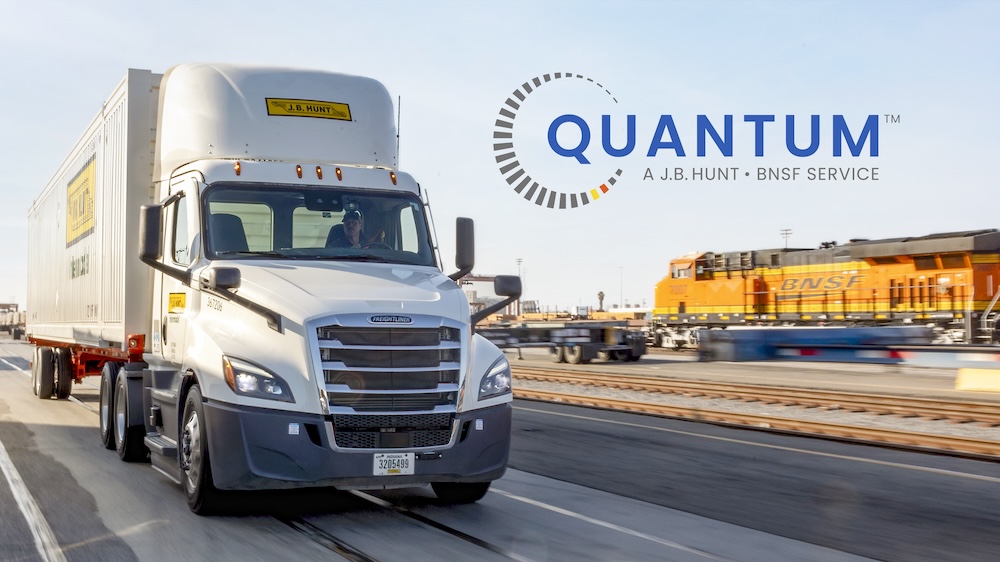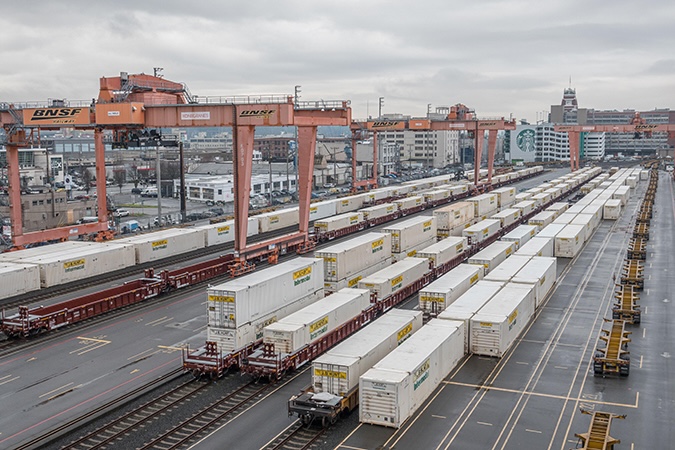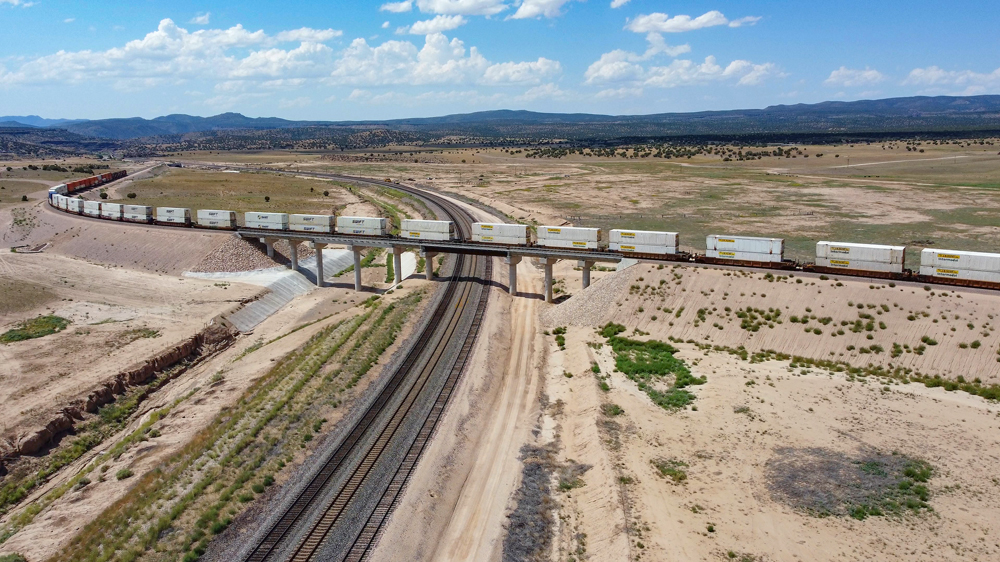
Intermodal analyst Larry Gross is fond of pointing out that rather than creating a truly competitive intermodal service that can attract freight from the highway, the Class I railroads have for too long relied on outside forces like truck driver shortages or high diesel fuel prices to push freight their way.
The strategy — or lack of one — hasn’t played out so well. You can see this in the market share that domestic intermodal has lost to long-haul trucking since 2017. Had railroads simply maintained their market share, Gross says, they would have carried nearly 18% more containers and trailers this year. Put another way, that translates into an additional 1.4 million loads and $3.5 billion in revenue.
In a move that counters this trend, J.B. Hunt and BNSF Railway this week unveiled a new premium domestic intermodal service. Their Quantum service is a day faster than traditional intermodal, shoots for 95% on-time performance, is built around each customer’s specific transit-time needs, and offers flexible pricing that sits between regular intermodal and over-the-road trucking rates.
This seems to be the right combination of speed, reliability, customization, and price necessary to attract the highly service-sensitive freight that has never ridden the rails before due to intermodal’s history of not being reliable enough. In other words, this bespoke service opens up a brand-new intermodal market. And it’s a big one: J.B. Hunt and BNSF estimate that Quantum can convert 7 million to 11 million truckloads to intermodal.
To put that into perspective, consider that J.B. Hunt handles a total of 2 million intermodal loads per year now and that overall U.S. domestic intermodal volume was 7.9 million containers and trailers last year.
But winning and keeping Quantum traffic will hinge on how well J.B. Hunt and BNSF meet their service commitments. The early results are promising: The Quantum pilot program loads posted an impressive 98% on-time performance record from door to door despite tighter schedules.
The faster transit times come largely from trimming fat from the dray moves at origin and destination. Inside of terminals, think of Quantum freight as first-class passengers, who are guaranteed seats, pay more for getting extra attention en route, and are the first ones off the train upon arrival.
The key question, of course, is whether BNSF and J.B. Hunt can maintain stellar on-time performance once the railroad and its terminals get busy. Railroads perform well when traffic is light, but have congested-related challenges once volume ramps up. Erratic service will drive Quantum traffic back to the highway faster than you can say traffic jam.
BNSF considers the railroad busy when weekly volume totals 200,000 or more intermodal units and carloads. During the Quantum trial moves, volume was well below that threshold: It averaged around 169,000 in July and rose to an average of about 187,000 in October.
Intermodal volume increased over that period, going from around 91,000 weekly loads in July to 101,000 in October. And in the last week of October, J.B. Hunt sent record volume across the BNSF network. To handle the surge, BNSF had to pull equipment out of storage and add train starts. It was a volume flex test — and one that BNSF aced, according to J.B. Hunt.

BNSF says it’s trying to make its intermodal service immune from swings in volume. It’s doing this by adopting new technology that should keep terminals fluid, as well as capitalizing on capacity investments in terminals and out on the main line. In recent years on the Southern Transcon, for example, BNSF has added third and fourth tracks at crew change points, built a third main track on heavy grades to allow intermodal trains to overtake drag freights, is double-tracking the few remaining single-track sections between L.A. and Chicago, and has constructed a flyover to speed the flow of trains across Arizona. Still to come: The massive Barstow International Gateway intermodal terminal and transload center.

What’s encouraging is that BNSF, like other Class I railroads, routinely provides flawless peak season service for UPS. This should mean that Quantum service can be reliable, too. Still, J.B. Hunt and BNSF — who now have a team of employees working shoulder to shoulder in the railroad’s headquarters in Fort Worth — will have to prove to customers that Quantum can deliver on the advertised.
Quantum revives a name that Santa Fe and J.B. Hunt initially applied to the TOFC service that sprang from a 1989 business-car handshake deal between ATSF President Michael Haverty and J.B. Hunt. Hunt saw the potential of intermodal, and his trucking company became the first to align itself with a railroad. It’s now by far the largest domestic intermodal company.
Is the new Quantum service the biggest thing to happen in domestic intermodal since The Handshake aboard train QNYLA?
“I think that it is,” Haverty says. “They are trying to get more quality truckload customers that are willing to pay the higher rates for premium service, maybe along the level of UPS, FedEx, and Amazon. When we started Quantum in 1989, our strategy was to offer premium service at rates below truckload rates, but above normal intermodal rates. Premium service, but not equal to our then-largest customer at the time, UPS, that ran trainloads of intermodal units on our expedited trains.”
If there’s a downside to the new Quantum, it’s that it’s a unicorn. It’s only possible due to the unique long-term partnership between BNSF and Hunt and the fact that J.B. Hunt is now BNSF’s lone domestic truckload customer. That makes it very difficult if not impossible to replicate on other railroads.
But on its own Quantum holds the potential to change the trajectory of domestic intermodal service.
You can reach Bill Stephens at bybillstephens@gmail.com and follow him on LinkedIn and X @bybillstephens















but does intermodel really take trucks off the hwy, No, almost every one of those containers will be on a hwy in a big city that already doesn’t have room for them. the only true way of taking trucks off the hwy is dock to dock with a rail car.
IMHO, the first and final mile dispatching expertise (in concert with close shipper “real needs” and dock availability) will lead to success. My experience is that many shippers and receivers will back in an OTR load before an intermodal load.
FYI, JB Hunt’s average length of haul for intermodal is 1,665 miles (Annual Report) versus 520 miles for their TL segment.
Most of the volume may very well rest in the short haul markets, but I can tell you from personal experience as a former Santa Fe intermodal pricing analyst that most of the profit rests in the longer haul markets.
To paraphrase John Dillinger, we operate the longer hauls because that is where the money is.
Quantum has a big potential to carry traffic to ./ from ATL (Fairburn) . However, a problem will be CSX capacity. The Lineville sub from BHM – LaGrange is still somewhat some what restricted on capacity. As well there is a short siding from LaGrange – Fairburn that is a choke point as well. That siding was once scheduled to be lengthened but PSR cancelled it but is beginning to be needed again.
Rails won’t really improve competition with trucking until it finds a way to fight for shorter hauls, where much of the real volume resides.
– Ed Kyle